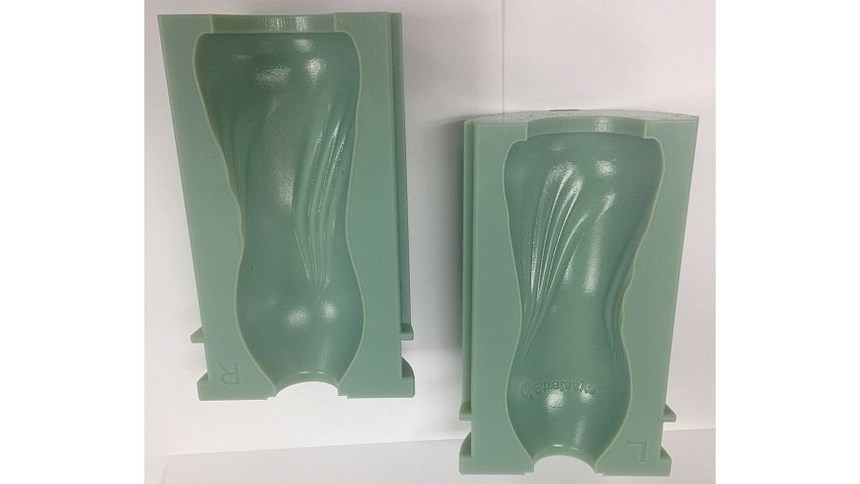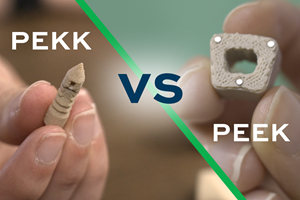Where Do 3D-Printed Molds Make Sense?
Stratasys describes the capabilities and limitations of 3D “digital ABS” molds for making plastic parts through injection molding or blow molding.
Share
Read Next
Is it possible to mold a plastic part using mold tooling that is also made of plastic? 3D printing technology provider Stratasys says this is not only possible, but preferable in some cases. These photos show examples of 3D-printed “digital ABS” tooling, which is used for both injection molding and blow molding.
The mold tooling material is produced on a Stratasys Connex 3D printer. This printer digitally creates combination materials by rapidly laying down tiny dots of different materials as it builds the part. To create mold tooling, it combines a heat-resistant plastic with a matrix engineered for high strength. The result is a material that can withstand both the high pressure and high temperature of a molding cycle. The mold tooling material is in fact one of the very strongest materials created on the Connex 3D printer, which is more frequently used to make multi-material prototype parts.
Stratasys sales manager Nadav Sella has been involved in the development of this machine’s application to mold tooling ever since an end user of the machine first hit on the idea of making molds this way nearly 5 years ago. He says the life of one of these digital ABS tools is heavily influenced by both the material being molded and the geometry of the part. On a six-cavity injection mold making ice cream spoons in polypropylene, he says the digital ABS mold delivered 600 spoons. By contrast, for more complex geometries using reinforced nylon, the tool might deliver 20 injected parts. In general, where tooling is needed for low quantities or for an initial run of parts, quickly 3D printing a mold can both save cost and speed the time to market, he says.
There are limitations. He and others within Stratasys have worked through a number of applications of digital ABS molds, and this has allowed them to develop a set of best practices that they share with users. That set of best practices keeps improving as digital ABS tooling is applied to more geometries and materials, he says, but the key is to respect the mechanical and physical properties of the tool. Heat conductivity is not like that of aluminum or tool steel, leading to tool design considerations aimed at avoiding heat concentration. One example concerns gate size and type; point gates, cashew gates and banana gates should be avoided.
Precision is also a consideration. The 3D printer is precise, but not as precise as a CNC machine tool. Thus, it can’t produce molds with the finest features, such as the tight-tolerance details of some electronics-industry molds. Also, to ensure the accuracy needed for precise seating of ejector pins, these holes should be 3D printed undersize, then reamed to achieve an accurate diameter.
“This is a different material,” he says. Established moldmaking professionals are accustomed to molds being made from metal. Compared to this, 3D printed tooling requires slight design and process changes. His advice to potential users is to expect to take some time getting used to what this option can do. However, “for the shop that does 100 molds per year—some in steel and some in aluminum—what if 10 or 20 of those molds could be 3D printed instead?” That portion is realistic, and could amount to considerable savings in cost and time.
Related Content
What Does Additive Manufacturing Readiness Look Like?
The promise of distributed manufacturing is alluring, but to get there AM first needs to master scale production. GKN Additive’s Michigan facility illustrates what the journey might look like.
Read MoreConcept Sneaker Boasts One-Piece 3D Printed TPU Construction
The Reebok x Botter Concept Sneaker Engineered by HP premiered at Paris Fashion Week, hinting at manufacturing possibilities for the future of footwear.
Read More3D Printed Spine Implants Made From PEEK Now in Production
Medical device manufacturer Curiteva is producing two families of spinal implants using a proprietary process for 3D printing porous polyether ether ketone (PEEK).
Read MoreUnderstanding PEKK and PEEK for 3D Printing: The Cool Parts Show Bonus
Both materials offer properties desirable for medical implants, among other applications. In this bonus episode, hear more from Oxford Performance Materials and Curiteva about how these companies are applying PEKK and PEEK, respectively.
Read MoreRead Next
Profilometry-Based Indentation Plastometry (PIP) as an Alternative to Standard Tensile Testing
UK-based Plastometrex offers a benchtop testing device utilizing PIP to quickly and easily analyze the yield strength, tensile strength and uniform elongation of samples and even printed parts. The solution is particularly useful for additive manufacturing.
Read MoreAlquist 3D Looks Toward a Carbon-Sequestering Future with 3D Printed Infrastructure
The Colorado startup aims to reduce the carbon footprint of new buildings, homes and city infrastructure with robotic 3D printing and a specialized geopolymer material.
Read MoreCrushable Lattices: The Lightweight Structures That Will Protect an Interplanetary Payload
NASA uses laser powder bed fusion plus chemical etching to create the lattice forms engineered to keep Mars rocks safe during a crash landing on Earth.
Read More



















